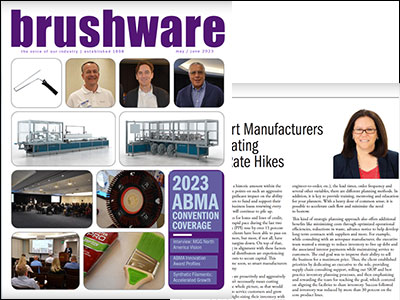Interest rates have increased by a historic amount within the last year. Increases of almost 5 points on such an aggressive timeline is already having a significant impact on manufacturers and distributor’s ability to fund and support their business growth. With typical business loans renewing every 5-7 years, the impacts will continue to pile up.
Published in Brushware, May-June, 2023
In addition to high interest rates for loans and lines of credit, costs have been increasing on a rapid pace during the last two years. The producer price index (PPI) rose by over 15% in the last two years. Typically, clients have been able to pass on part of these increases to customers, but most if not all have absorbed part as well, driving margins down. On top of that, wage rates have been increasing in alignment with these factors as well. Thus, manufacturers and distributors are experiencing higher input costs and higher costs to secure capital. This situation will not change anytime soon, and so smart manufacturers must take control of their destiny.
Smart manufacturers are proactively and aggressively managing inventory. They are not reducing inventory with no vision to the future as that would negatively impact their ability to service customers and grow the business; instead, they are right sizing their inventory with best practice supply chain planning processes. Start with SIOP (Sales Inventory Operations Planning), also known as S&OP as this process defines your demand plan and sales forecast and determines how to best supply that plan to reliably service customers at the lowest cost and with the least amount of inventory tied up unnecessarily. The SIOP process will also highlight the appropriate strategic decisions required to keep ahead of changing conditions.
Beyond SIOP, best practice supply chain planning processes encompasses the end-to-end supply chain from material planning to determine what to order from suppliers to production planning / scheduling to determine what to run to optimize your manufacturing facility, serve customers and minimize safety stock inventory to distribution / replenishment planning to get the right product to the right place at the right time. Depending on your manufacturing process (make to stock, configure to order, engineer to order, etc.), lead times, order frequency, and several other variables, there are different planning methods. In addition, provide training, mentoring, and education for your planners, add a heavy dose of common sense, and you will minimize your need to borrow and accelerate your cash flow. These processes have the extra benefit of minimizing your costs by maximizing operational efficiencies, reducing waste, providing advance notice to develop long term contracts with suppliers, and more.
For example, while consulting with an aerospace manufacturer, executives wanted to focus on reducing inventory to free up debt and the associated interest payments while maintaining service to customers to improve their ability to sell the business for a maximum price. Thus, the client established priorities by dedicating an executive to the role, provided supply chain consulting support, rolled out SIOP and best practice inventory planning processes, and emphasized and rewarded the team for the common goal (inventory levels). The common goal was important in aligning the facilities to share inventory. Success followed and inventory was reduced by more than 30% on the core product lines.
Smart manufacturers will not only successfully navigate turbulent times with rising interest rates, but they will also be better prepared to serve customers successfully and be resilient to changing conditions. Prioritize SIOP, roll out best practice supply chain planning processes, and support your resources and success will follow.



